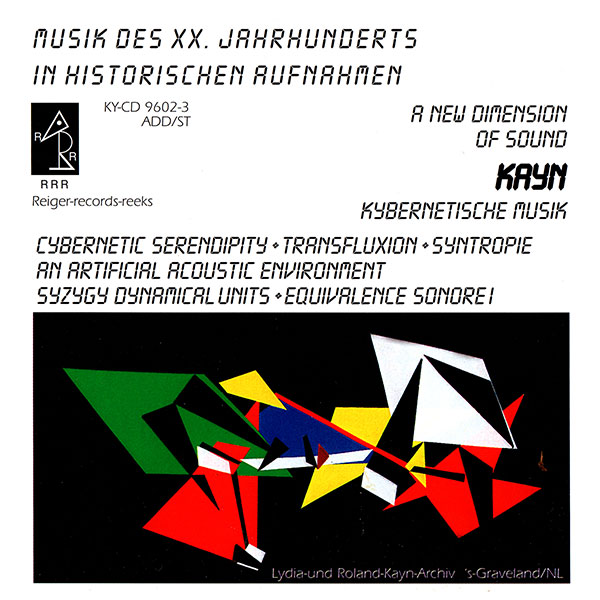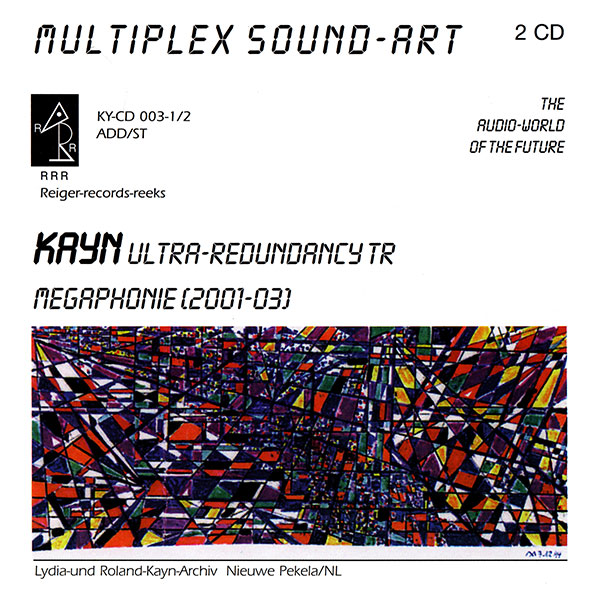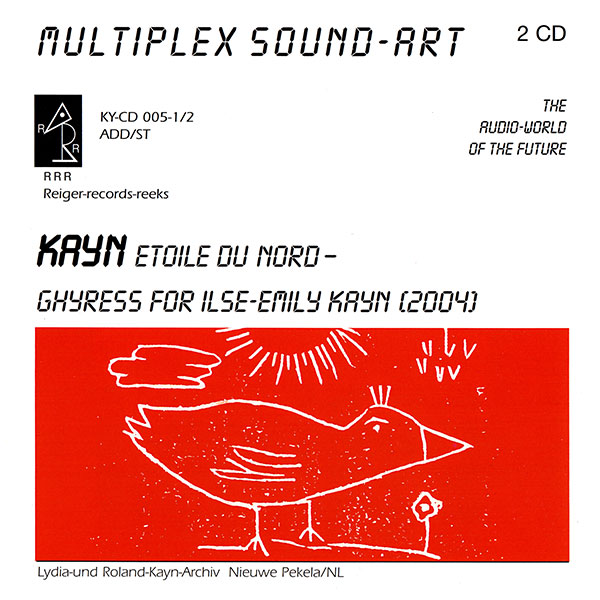Introduction to Roland Kayn
Roland Kayn was born in Germany in 1933 and started composing at an early age. He was just 20 years old when he won first prize at the festival of 20th century music in Karuizawa, Japan. Performances of his composition Aggregate (1959) resulted in him becoming persona non grata on the concert stage. Shortly after working in electronic studios in Poland, Germany and Italy, he joined the Gruppo Nuova Consonanza and this crucial detour into improvisation with Franco Evangelisti, Aldo Clementi and Ennio Morricone helped him find his definitive musical direction. Kayn decided to pursue his musical quest through composition with the intention, strange as it may seem, of excluding the composer as much as possible. He concentrated solely on electronic and electro-acoustic music from 1970 onwards.
From an early age, Kayn was influenced by information theorists rather than other composers, and it was as a result of this that he started using the term "cybernetic" when describing his music. Basically, Kayn would design networks of electronic equipment and then develop a system of signals and commands that it could obey and execute. Words like "melody," "harmony," and "rhythm" do not apply to Kayn's music. Music, supposedly, should have every detail defined by the composer. Kayn insisted that his "cybernetic" music should regulate itself, thereby relinquishing the narrative elements and the psycho-emotional details usually associated with the ideas of "authorship" and "work of art." This meant that even he could not predict the eventual composition, which were sound processes without an epicentre, where every sound is equally important. For Kayn, "Music is sound, which is sufficient in itself." Roland Kayn felt that present day composers should avail themselves of the electronic techniques at their disposal and that electronic music is more than just the result of rapidly expanding technology.
- Frans van Rossum

Explore the music of Roland Kayn
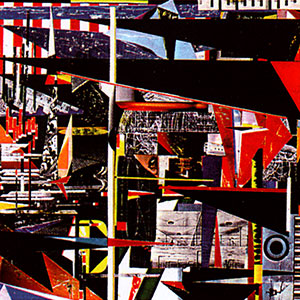
Cybernetic Music
Cybernetic music - whether it is produced vocally, with instruments or electronically - is not initially "composed" and practised. It arises from the interplay of merged control loops setting a process into motion. In this instance, selected data – such as instructions and/or electronic signals directed to an information-processing memory (man, machine) – become particularly important. This composite of systems partially based on feedback gives life to a kind of educational process, which - in contrast to conventional processes - can be entirely autonomous.
During chemical engineering processes studied on the microscope there is evidence of the possibility of rejections. Similarly, propagations of surface formations of elements, diffusions of rhythmic pulsations, colour shifts and specific effects can lead to new constellations (reactions). Analogously, and especially in the electroacoustic area, heuristic processes may be discovered that largely correspond with the above-mentioned phenomena, whereby however the composer entirely loses his original function. He is only able to decide if he will engage, control and regulate, or if he is simply willing to accept the outcome as an autonomously generated operation. Music as a "time art" becomes evident at first via the actual air surrounding the listener; ultimately, it contains - from a purely physical perspective - nothing but its molecules, converted into determined or random positions via mechanical or electro-acoustically generated signals.
The first models for music of this type include Rolands Kayn's GALAXIS, multiple sound structures for variable instrumental ensembles (Moeck Verlag, Celle 1962); and, in the electroacoustic field, CYBERNETICS (Studio di Fonologia, RAI, Milan 1969). Kayn's main commitment was directed to the development of widely diverse cybernetically generated projects stemming from electroacoustics, including – among others - SIMULTAN, MAKRO, INFRA and SCANNING. This music, delivered as it is from rules and obligations linked to traditional performance practice and from sociological contexts, impressively fused technological and humanistic aspects.
Electronic Symphonies
The ten Electronic Symphonies - written between 1966 and 1996 - represent a journey through a soundscape where phases of the works from this period (to be considered as the past) constantly meet what is contemporary, while also reflecting impulses. In regard to the selection, self-contained "objects trouvés" were given priority as the pieces were being generated in the studio. Their concretion developed in real time from a complex electronically autonomous system. Since the process cannot be traced back at a later date, the documentation on sound storage mediums becomes essential given that the corresponding details cannot be disclosed, thus abdicating traditional authorship.
This "music" thereby exceeds the empirical category of commonly known music. It contains something which was so described by composer Franco Evangelisti "... as arriving at something that suddenly can no longer be called music".
[Franco Evangelisti: "Vom Schweigen zu einer neuen Klangwelt" (From Silence to a New World of Sound), published by Edition TEXT und KRITIK, Munich 1985].
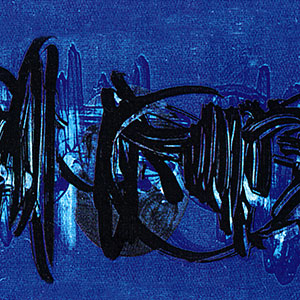

Keyboard Works
Orchestra and ensemble works
At the age of seventeen Roland Kayn composed his orchestral piece No. 1, titled "Metanoia". A revision of the piece appeared in 1989. From the outset, Kayn's compositional interest was focused on large orchestras and ensembles of varied instrumentation. Chamber music was almost absent from his oeuvre. Similarly to the first orchestral work, some subsequent scores remained unperformed. Between 1959 and 1980 there were presentations of works in this category during festivals and international concert series. Kayn's early focus was on electronic music. The obstinate resistance in the politics of performance through conventional instruments (the practices of Amsterdam Concertgebouw Orchestra or Berlin Philharmonic come to mind in this context) led him to withdraw from the concert ambit in 1980. These recordings are not without flaws in terms of sound quality and technical aspects of the performance; thus, their principal aim is to represent a historical documentation. Quite frequently, Kayn recorded his unusual musical conceptions by making use of new forms of notation. Due to the general shrinkage of concert rituals in the music of this century, the composer saw electronic music as the only alternative to reach a large audience via digital satellite radio reception. If the thesis of Heinz-Klaus Metzger is correct – namely, a composer cannot be measured by what he creates, but rather by what he does discard – this would be a circumstance where, to a large degree, the recordings presented here fittingly come into focus.
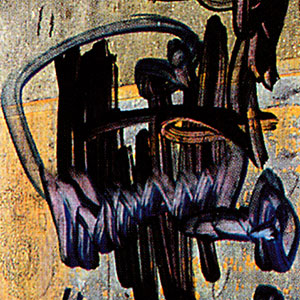
Kayn Recordings
Since its first release in 1995, Roland Kayn's personal recording label Reiger-records-reeks has been sharing Kayn's works through a series of CDs.
Now, after a long hiatus, we are pleased to announce that Reiger-records-reeks will resume the releasing of Kayn's works on CD, vinyl, and through digital downloads.
Kayn in Print
Contact
For all enquiries related to the Roland Kayn estate, performances, and other information, please contact ilse@kayn.nl.




